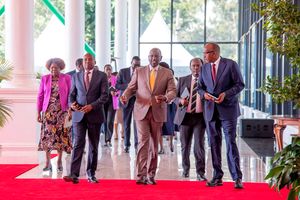Premium
What does Hezbollah's arsenal look like?

Members of Shiite movement Hezbollah hold a military parade in the town of Riyaq in Lebanon's Bekaa Valley on February 13, 2021 marking the annual anniversary of "martyred" leaders.
Lebanon's Hezbollah has been trading daily cross-border fire with its sworn enemy Israel as war rages in Gaza, with the Iran-backed group deploying a large weapons arsenal amassed over decades.
AFP looks at the Shiite Muslim group's firepower and how it has expanded since it fought a war with Israel in 2006.
Armed and dangerous
Hezbollah is the only Lebanese faction to have retained its weapons after the end of Lebanon's 1975-1990 civil war, and is now considered to have a more powerful stockpile than the national army.
It is also the most powerful group in the "axis of resistance" -- an alliance of Tehran-supported groups mainly in Iraq, Syria, Yemen and the Palestinian territories.
The 2006 Israel-Hezbollah war killed more than 1,200 people in Lebanon, mostly civilians, and 160 in Israel, largely soldiers.
Since then, "Hezbollah has robustly expanded the quantity and the quality of its arsenal," said Dina Arakji from Control Risks consultancy.
"The group in 2006 reportedly had about 15,000 rockets, while estimates over the past couple of years suggest that this number has multiplied by almost 10 times," she said.
The group has also gained significant combat experience after years of fighting on the side of President Bashar al-Assad in Syria's civil war.
Skirmishes on the Lebanon-Israel border began on October 8, one day after Hamas attacks against Israel sparked war, but so far Hezbollah has largely limited itself to targeting sites near the Israeli border.
Hezbollah chief Hassan Nasrallah has repeatedly said his group holds advanced weaponry capable of striking deep into Israeli territory.
Fighters and tunnels
In 2021, Nasrallah claimed his group had some 100,000 "trained" and "armed" fighters.
But Arakji said the number was "likely to be inflated".
The group's fighters include an elite force known as the Radwan unit, which "could be described as the group's special forces", Arakji added.
Since the 2006 conflict ended, the Shiite Muslim group has not had a visible military presence on Lebanon's southern border, which is patrolled by United Nations peacekeepers.
But Hezbollah has maintained large influence in Lebanon's south, where it has built hideouts and tunnels.
Israel has accused Hezbollah of building cross-border tunnels and has claimed to have destroyed several.
The tunnel network "is likely to be extensive", said Arakji, adding that "there is no indication... that Hezbollah has stopped constructing them".
Precision guided missiles
In September 2018, Nasrallah said his group had acquired "precision missiles" despite Israeli efforts to prevent it from doing so.
Arakji said precision guided missiles could allow the group to "strike targets with a higher level of accuracy and lower margins of error".
In February 2022, Nasrallah said Hezbollah had "the capacity to transform our missiles into precision missiles".
In August this year, he said it would take just "a few high-precision missiles" for the group to destroy Israeli targets including "civilian and military airports, airbases, power stations" and the Dimona nuclear facility.
Guided missiles
Hezbollah has been using guided missiles extensively in the latest cross-border clashes, particularly against Israeli tanks.
In August, the group announced it had a weapon dubbed "God's Revenge", designed to fire Russian Kornet anti-tank missiles.
The double launcher is capable of "accurately hitting targets simultaneously and destroying them", according to Hezbollah's official media.
Unguided missiles
Hezbollah holds unguided surface-to-surface rockets, which formed the bulk of its arsenal during the 2006 war, including Katyushas.
On Saturday, Nasrallah said that for the first time, the group was using Burkan missiles, adding that they could carry "a payload of 300-500 kilogrammes" (660-1,100 pounds).
Anti-aircraft
Hezbollah holds surface-to-air missiles, with the group claiming to have downed Israeli drones in the latest round of fighting.
A Hezbollah video released in 2019 showed shoulder-held surface-to-air weaponry as the group threatened to target Israeli unmanned aerial vehicles.
Anti-ship
Hezbollah first used anti-ship weaponry in 2006 against an Israeli naval vessel, the INS Hanit, stationed off Beirut.
In 2019, the group published video footage showcasing Chinese-made C-802 and C-704 anti-ship missiles.
In 2022, before Lebanon and Israel reached a US-mediated maritime border deal, Hezbollah threatened to strike Israeli off-shore gas platforms.
Drones
Hezbollah has unmanned aerial vehicles including surveillance and attack drones, some of which it put on show in May during a display of military might.
Nasrallah said Saturday that the group has been using attack drones "for the first time" and has been flying "reconnaissance drones" deep into Israel daily.





